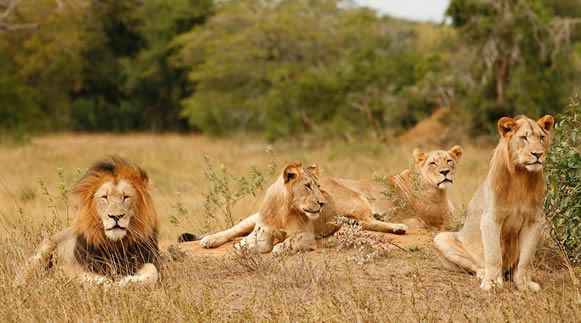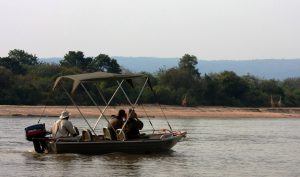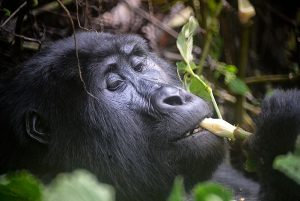Uganda hosts several national parks that offer exceptional opportunities to see lions in their natural habitat. The most prominent parks for lion sightings include Queen Elizabeth National Park, Murchison Falls National Park, and Kidepo Valley National Park. Queen Elizabeth National Park is particularly famous for its tree-climbing lions in the Ishasha sector, a rare behavior that attracts wildlife enthusiasts from around the world. Lions here often rest in fig trees and acacia branches during the heat of the day, creating unforgettable photographic moments. Murchison Falls National Park provides vast savannahs and riverine forests, where lions hunt alongside elephants, buffalo, and antelopes. Kidepo Valley National Park, in the remote northeast, hosts healthy lion populations due to minimal human disturbance, and its open plains allow visitors to spot these predators over long distances. Collectively, these parks ensure that travelers have multiple options for witnessing lions in Uganda’s diverse landscapes.
Which National Park in Uganda Has the Most Lions?
Queen Elizabeth National Park ranks as the top destination for lion sightings in Uganda. The Ishasha sector, in particular, boasts some of the highest concentrations of lions in the country. Here, the unique tree-climbing behavior distinguishes the lions from populations elsewhere in Africa. Murchison Falls National Park also supports a significant lion population, primarily concentrated in open savannah areas and along the Nile River. Kidepo Valley National Park, while more remote, offers a high density of lions due to lower human activity and abundant prey species. The number of lions in Uganda is estimated to be several hundred, though populations fluctuate seasonally and regionally depending on prey availability, habitat conditions, and conservation efforts.
When Is the Best Time of Year to See Lions in Uganda?
Travelers see lions most reliably during Uganda’s dry seasons, from December to February and June to August. During these months, vegetation thins and animals gather around water sources, making predators like lions easier to spot. Early morning and late afternoon are the ideal times for game drives, as lions actively hunt or move between shaded areas and open plains. In contrast, the wet seasons often reduce visibility because tall grasses hide the animals and rainfall can limit accessibility to certain areas. Planning a visit during the dry seasons maximizes the chances of observing large prides in hunting or resting behavior and provides optimal lighting for photography.
Can You See Tree-Climbing Lions in Uganda?
Yes, visitors can observe tree-climbing lions in Uganda, particularly in the Ishasha sector of Queen Elizabeth National Park. These lions climb fig and acacia trees to rest during the heat of the day, an uncommon behavior in most lion populations. Tree climbing allows lions to avoid biting insects, regulate their body temperature, and gain a vantage point to monitor prey. Wildlife guides often know specific trees where lions frequently rest, improving the chances of sighting these extraordinary behaviors. Photographers and wildlife enthusiasts find tree-climbing lions especially appealing because they provide unique perspectives not commonly seen on African safaris.
How Close Can Tourists Safely Get to Lions in Uganda?
Tourists can safely observe lions in Uganda while maintaining a responsible distance to avoid disturbing the animals. Safari vehicles typically keep at least 30–50 meters from lions in open terrain, allowing clear views without causing stress to the predators. Trained guides ensure that drivers follow park regulations and approach prides cautiously, using experience to track lion movements while prioritizing safety. Observing from designated roads, viewpoints, or guided walking safaris provides intimate encounters without compromising visitor safety or wildlife welfare. Following park rules ensures that tourists enjoy lion sightings while supporting conservation and ethical wildlife tourism practices.
Are There Guided Safaris to See Lions in Uganda?
Uganda offers numerous guided safari options designed specifically for lion observation. Safari operators provide expert guides who know the best locations, peak viewing times, and lion behaviors. Guided tours typically include transportation to national parks, game drives in open savannahs, and optional walking safaris in controlled areas. Many tours also provide binoculars, spotting scopes, and insights into predator-prey dynamics, ecological significance, and local conservation initiatives. Participating in guided safaris increases the chances of seeing lions while ensuring safe, informative, and structured wildlife experiences. Additionally, guided tours support local communities and national park management programs, contributing to long-term wildlife protection.
What Other Wildlife Can You See Alongside Lions in Uganda?
Visitors often encounter a variety of wildlife alongside lions in Uganda’s national parks. Queen Elizabeth National Park and Murchison Falls National Park host elephants, African buffalo, giraffes, and several antelope species, including kob, waterbuck, and Uganda kob. Hippos and crocodiles are abundant in rivers and wetlands. Predators such as leopards and hyenas share habitats with lions, providing opportunities to observe interspecies interactions. Kidepo Valley National Park also supports cheetahs, wild dogs, and jackals, creating a dynamic ecosystem for wildlife enthusiasts. Birdwatchers can enjoy diverse species, including eagles, vultures, and pelicans, making Uganda a comprehensive safari destination beyond lion observation.
Which Lodges or Camps Are Near Uganda’s Lion Habitats?
Several lodges and safari camps provide convenient access to Uganda’s lion habitats. In Queen Elizabeth National Park, lodges near Ishasha and Kasese offer guided game drives with sunrise and sunset options for lion sightings. Murchison Falls National Park features riverside lodges and safari camps near the Nile that provide close proximity to lion-rich areas. Kidepo Valley National Park offers remote luxury lodges and tented camps that combine comfort with immediate access to lion viewing zones. These accommodations typically arrange guided tours, private game drives, and wildlife photography excursions, ensuring that visitors can experience lions in optimal conditions while staying in safety and comfort.
How Many Lions Live in Uganda’s National Parks?
Uganda maintains several hundred lions across its national parks, with estimates varying based on survey data, seasonal migration, and prey abundance. Queen Elizabeth National Park hosts a robust population, particularly in the Ishasha sector. Murchison Falls National Park and Kidepo Valley National Park also sustain healthy populations, although exact numbers fluctuate annually. Conservation programs and anti-poaching initiatives contribute to population stability by protecting lions’ habitats and ensuring prey availability. Monitoring programs conducted by park authorities and researchers help track lion health, pride structure, and territorial behavior, ensuring sustainable management of Uganda’s lion populations.
Why Are Lions Important to Uganda’s Ecosystems?
Lions play a critical role as apex predators in Uganda’s savannah and forest ecosystems. They regulate prey populations, which prevents overgrazing and maintains healthy vegetation. By targeting weaker or sick individuals, lions contribute to the overall fitness of herbivore populations. Their presence supports biodiversity by influencing the behavior and distribution of other wildlife species. Additionally, lions attract significant ecotourism, generating revenue that funds park management, local communities, and conservation projects. Protecting lions therefore has ecological, economic, and cultural significance, making them one of Uganda’s most valuable wildlife assets.
Conclusion
Uganda offers unparalleled opportunities to observe lions in the wild, whether in the tree-climbing prides of Queen Elizabeth National Park, the expansive savannahs of Murchison Falls, or the remote plains of Kidepo Valley. Visitors maximize their chances of sightings by traveling during dry seasons, joining guided tours, and using experienced guides to navigate the parks safely. In addition to lions, travelers encounter a rich variety of wildlife, from elephants and buffalo to cheetahs and exotic birds, creating a full safari experience. By following ethical wildlife practices and supporting local conservation efforts, tourists help protect Uganda’s lions for future generations, ensuring that these iconic predators continue to thrive in their natural habitats.




